EGR VALVE > INSTALLATION |
for Preparation Click here
| 1. INSTALL ELECTRIC EGR CONTROL VALVE ASSEMBLY |
Install a new gasket.
Text in Illustration *1 Protrusion - NOTICE:
- Make sure the protrusion of the gasket is facing upward as shown in the illustration.
 |
Install the electric EGR control valve.
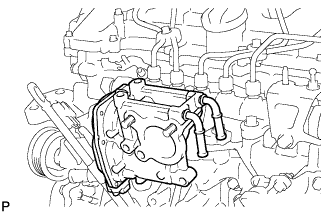 |
| 2. INSTALL NO. 2 EGR PIPE SUB-ASSEMBLY |
Install a new gasket to the electric EGR control valve.
Install a new gasket to the No. 2 EGR pipe.
Temporarily install the No. 2 EGR pipe with the 3 bolts and 2 nuts.
Text in Illustration *1 Nut - Standard Bolt:
Item Length Bolt A 25 mm (0.984 in.) Bolt B 70 mm (2.76 in.)
 |
Tighten the 2 bolts labeled A shown in the illustration.
- Torque:
- 24 N*m{ 245 kgf*cm , 18 ft.*lbf }
Tighten the bolt and 2 nuts labeled B shown in the illustration.
- Torque:
- 24 N*m{ 245 kgf*cm , 18 ft.*lbf }
Connect the electric EGR control valve connector.
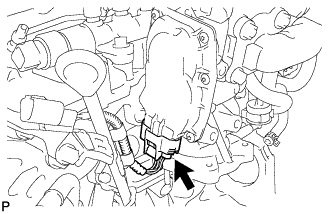 |
| 3. CONNECT NO. 8 WATER BY-PASS HOSE |
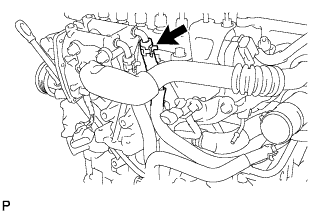 |
| 4. CONNECT NO. 7 WATER BY-PASS HOSE |
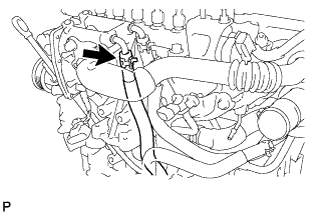 |
| 5. INSTALL EGR VALVE BRACKET |
Install the EGR valve bracket with the 3 bolts.
- Torque:
- 24 N*m{ 245 kgf*cm , 18 ft.*lbf }
 |
Connect the 2 connectors and attach the 2 wire harness clamps.
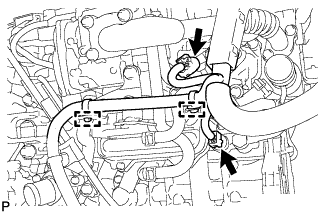 |
| 6. ADD ENGINE COOLANT |
Tighten the radiator drain cock plug by hand.
Tighten the cylinder block drain cock plug.
- Torque:
- 13 N*m{ 130 kgf*cm , 9 ft.*lbf }
Add TOYOTA Super Long Life Coolant (SLLC) to the radiator reservoir filler opening.
Continue adding TOYOTA SLLC until it is filled to the B line.
- HINT:
- The B line is the lower edge of the inner wall of the filler neck.
- Standard Capacity:
Item Specified Condition w/o Combustion Type Power Heater 7.3 liters
(7.7 US qts, 6.4 Imp. qts)w/ Combustion Type Power Heater 7.7 liters
(8.1 US qts, 6.8 Imp. qts)
- HINT:
- TOYOTA vehicles are filled with TOYOTA SLLC at the factory. In order to avoid damage to the engine cooling system and other technical problems, only use TOYOTA SLLC or similar high quality ethylene glycol based non-silicate, non-amine, non-nitrite, non-borate coolant with long-life hybrid organic acid technology (coolant with long-life hybrid organic acid technology is a combination of low phosphates and organic acids).
- NOTICE:
- Never use water as a substitute for engine coolant.
 |
Press the inlet and outlet radiator hoses several times by hand, and then check the level of the coolant.
If the coolant level drops below the B line, add TOYOTA SLLC to the B line.
Install the radiator reservoir cap.
Start the engine, and warm it up until the cooling fan operates.
Set the air conditioning as follows while warming up the engine.
Measurement Condition Item Condition Manual Air Conditioning System Fan speed - Any setting except "OFF" Temperature - Toward WARM
Air conditioning switch "OFF"Automatic Air Conditioning System Temperature - Toward MAX
Air conditioning switch "OFF"Maintain the engine speed at 2000 to 2500 rpm and warm up the engine until the cooling fan operates.
- NOTICE:
- Make sure that the radiator reservoir still has some coolant in it.
- Pay attention to the needle of the water temperature meter. Make sure that the needle does not show an abnormally high temperature.
- If there is not enough coolant, the engine may burn out or overheat.
- Immediately after starting the engine, if the radiator reservoir does not have any coolant, perform the following: 1) stop the engine, 2) wait until the coolant has cooled down, and 3) add coolant until the coolant is filled to the B line.
- Until the coolant level has stabilized, run the engine at 2000 rpm.
Press the inlet and outlet radiator hoses several times by hand to bleed air.
- CAUTION:
- When pressing the radiator hoses:
- Wear protective gloves.
- Be careful as the radiator hoses are hot.
- Keep your hands away from the radiator fan.
Stop the engine and wait until the coolant cools down to ambient temperature.
Check that the coolant level is between the FULL and LOW line.
If the coolant level is below the LOW line, repeat all of the procedures above.
If the coolant level is above the FULL line, drain coolant so that the coolant level is between the FULL and LOW line.
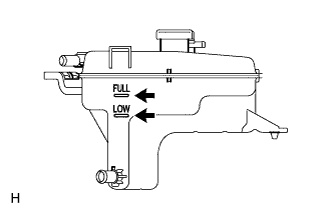 |
| 7. INSPECT FOR COOLANT LEAK |
Remove the radiator reservoir cap.
- CAUTION:
- To avoid the danger of being burned, do not remove the radiator reservoir cap while the engine and radiator are still hot. Thermal expansion will cause hot engine coolant and steam to blow out from the radiator.
Fill the radiator with coolant, and then attach a radiator cap tester.
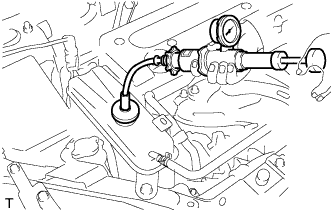 |
Warm up the engine.
Pump the radiator cap tester to 118 kPa (1.2 kgf/cm2, 17 psi), and then check that the pressure does not drop.
If the pressure drops, check the hoses, radiator and water pump for leakage.
If there are no signs of external coolant leaks, check the heater core, cylinder block and head.
Reinstall the radiator cap.
| 8. INSTALL NO. 1 ENGINE UNDER COVER |
Install the engine under cover with the 6 bolts and 10 clips.
| 9. INSTALL RADIATOR SUPPORT OPENING COVER |
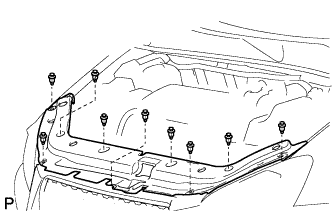 |
Install the radiator support opening cover with the 9 clips.
| 10. INSTALL NO. 1 ENGINE COVER |
Attach the 4 clips to install the engine cover.
 |
| 11. PERFORM ELECTRIC EGR CONTROL VALVE FULLY CLOSED POSITION LEARNING |
- HINT:
- Be sure to turn off the ignition switch before performing this operation.
Turn the ignition switch to ON.
Turn the ignition switch off and wait 30 seconds.
- HINT:
- The fully closed position of the electric EGR control valve is learned when the ignition switch is turned off.
